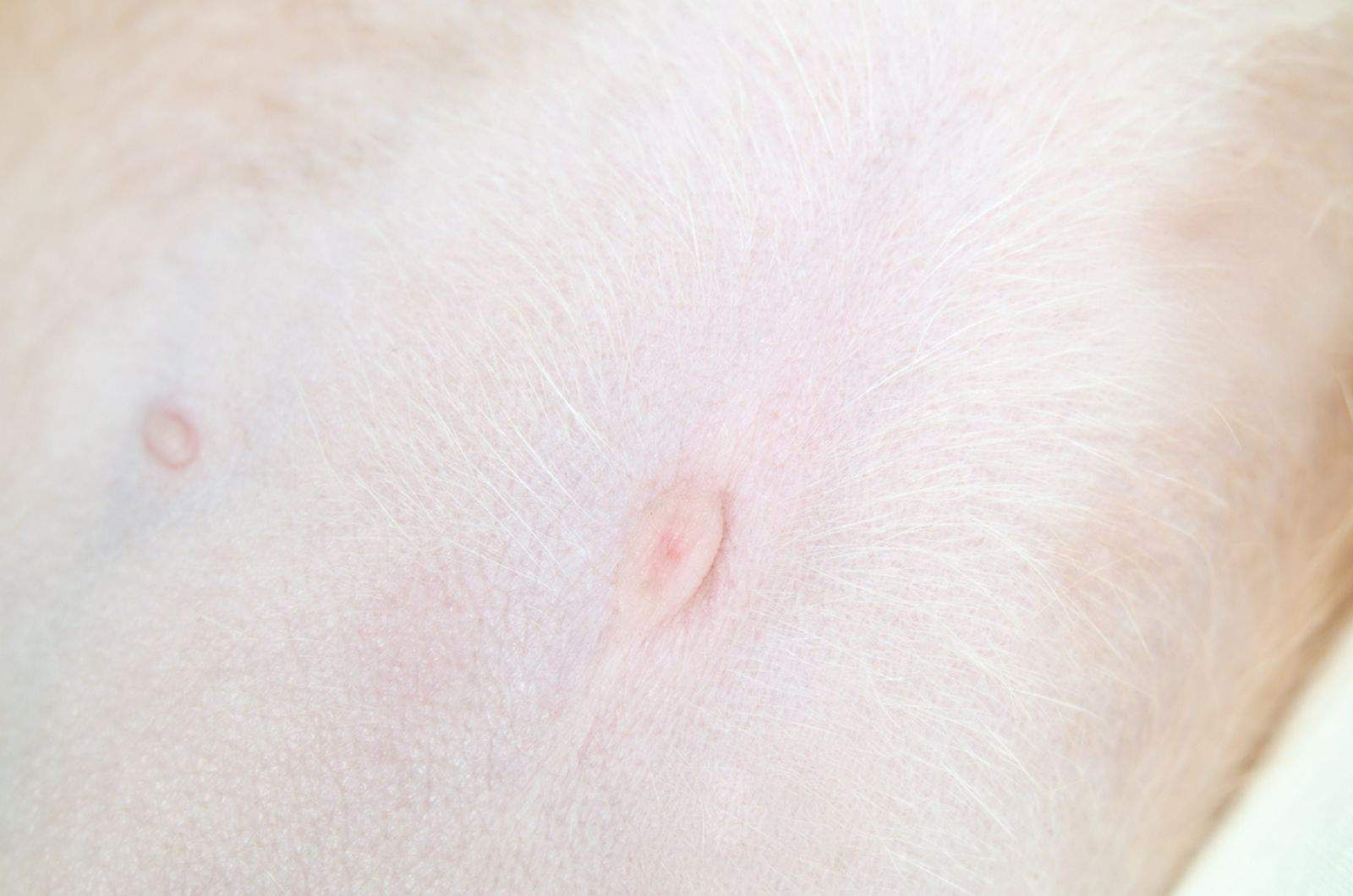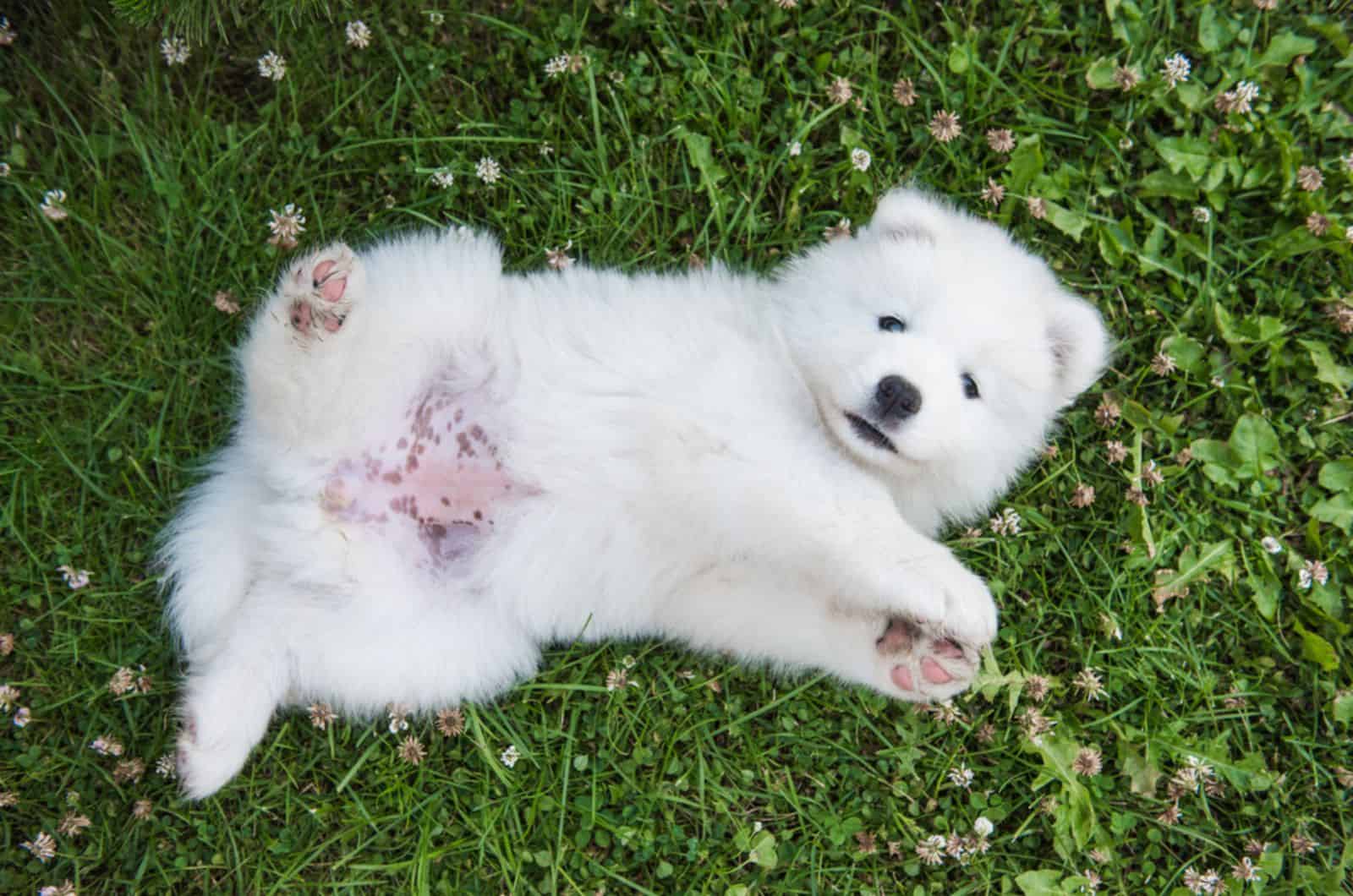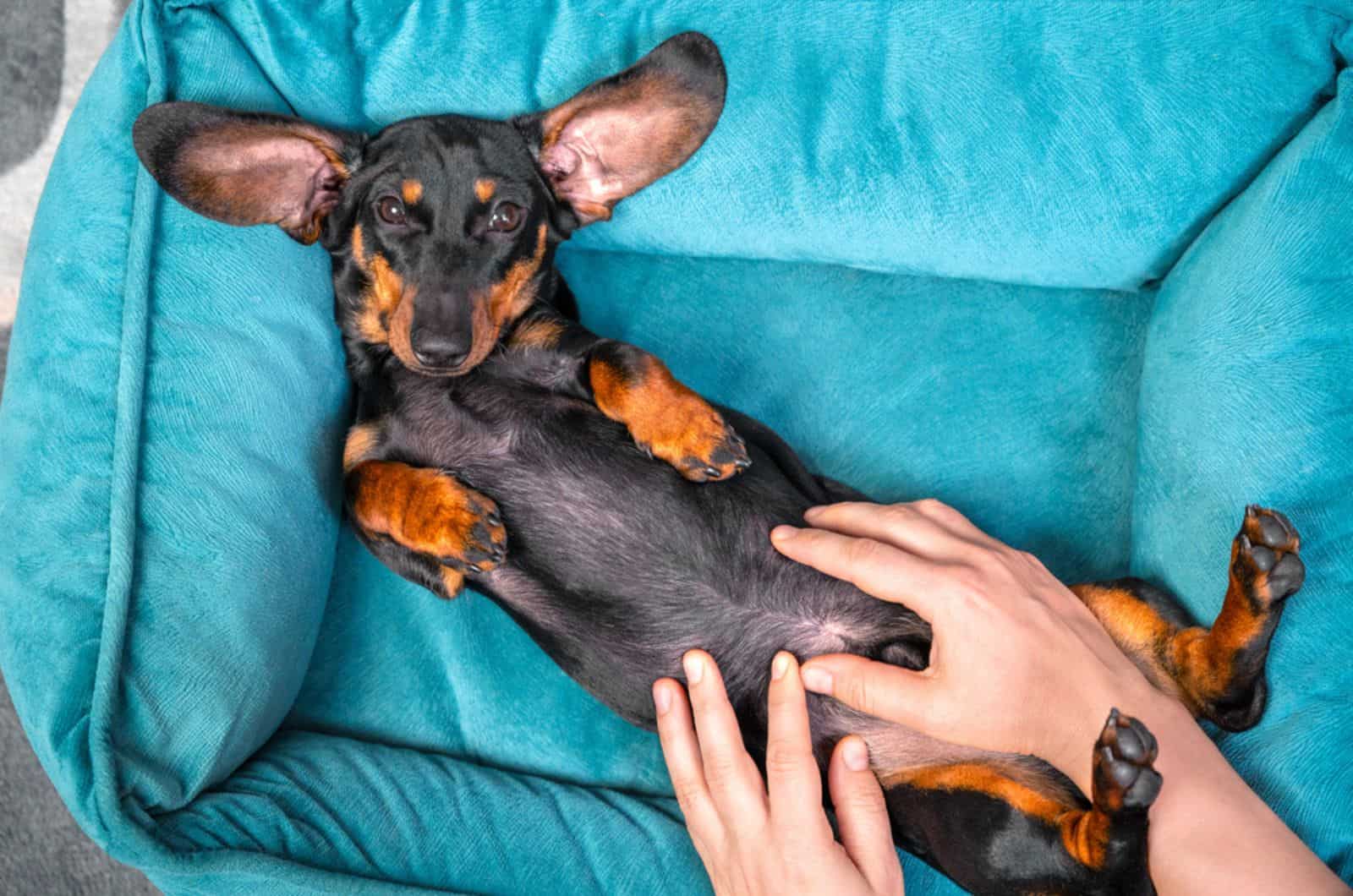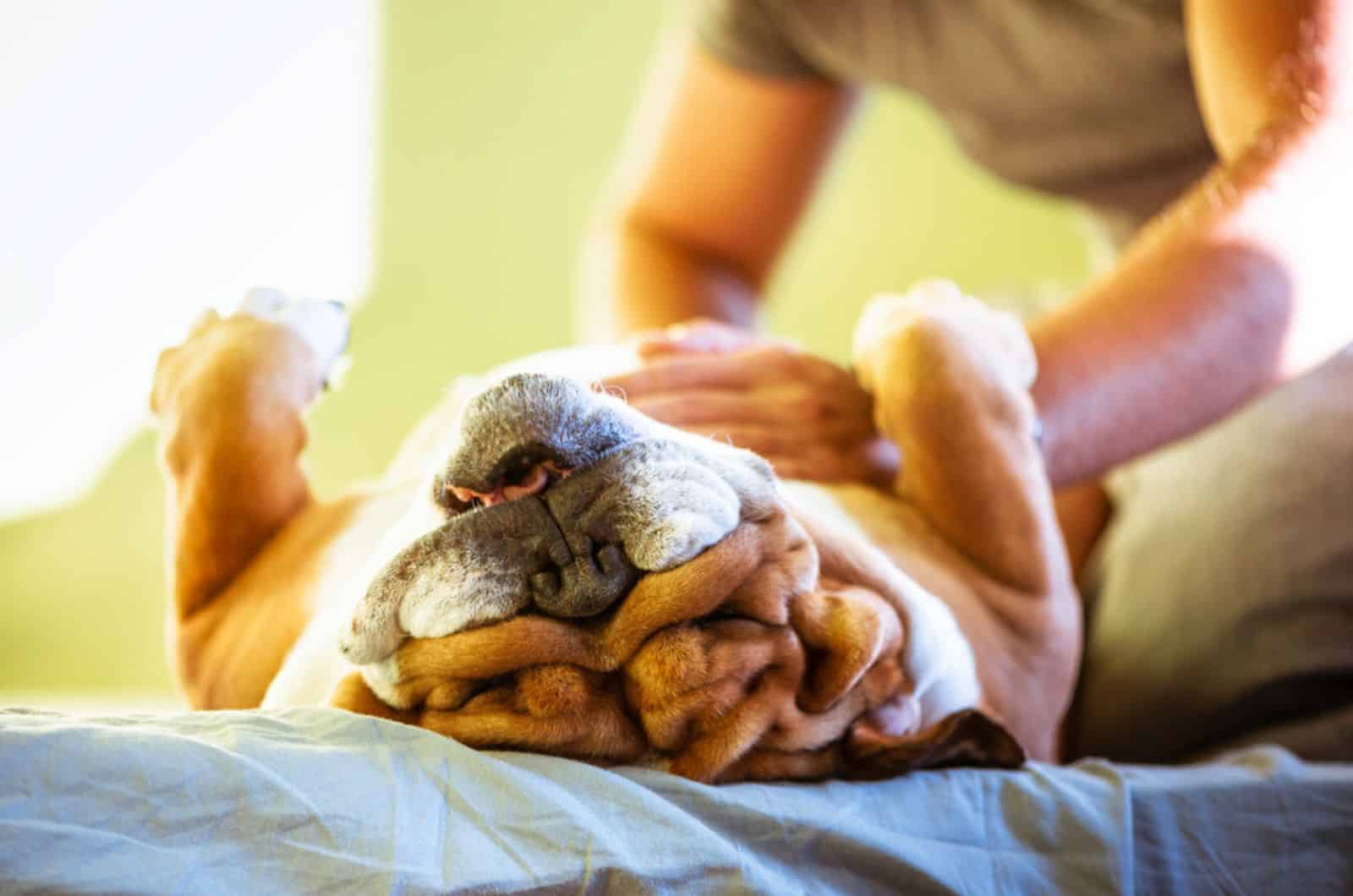Owning a dog is a beautiful thing, right? We completely agree that it is. Your pooch is a true ball of energy that can make everyone happy. Besides the lovely, and even some bad things, you need to admit that dogs are truly mysterious at times.
There are a lot of things that can pop into our mind. Some are explainable and more logical than others. For example, you may ask yourself: Why do dogs wag their tail, and you can always find the answer by checking out the dog tail position chart.
Other things may be a bit more interesting and not that known. One of those things is a question that some dog owners are wondering about, and that is: ˝Do dogs have belly buttons?˝
Well, luckily, we are here to answer that question for you, and give you all the information that you might want to know. There are quite a lot of things that we need to go through so let us start the ride.
Do Dogs Have Belly Buttons?

The short answer and, well… the only answer is, YES! Dogs do have a belly button. They are not quite like the belly button we humans have, but they are for sure there.
You probably did not notice your dog having a belly button, and that is completely normal, especially if your dog has a long coat. It can be almost impossible to see it even when you are trying to find it.
Don’t worry – this is not something to be ashamed of. You need to know a couple of things in order to be able to find it, and we will provide you with all the information. Before we start with that, we want to explain why dogs have a belly button.
Dogs are placental mammals, and this is something that they have in common with us. Placental mammals are the ones that have a belly button.
Oviparous animals (or monotremes… platypus), and marsupials (kangaroos), are the ones that don’t have a belly button. Oviparous animals lay eggs, and because of that, they will not have the scar of the umbilical cord. Marsupials develop their babies in their pouches, and these babies will also not have a belly button.
Now that you know this, we can give you more information, which can make things a bit clearer.
What Is A Belly Button?

As placental mammals, dogs develop within the mother’s womb during gestation. In that womb, every puppy will be placed in a placenta. The placenta is very important because it provides the puppy with oxygen and various nutrients that will be keys for the development of the puppy and for keeping it alive.
The reason why the puppy does not leave the mother’s placenta is due to the umbilical cord. Every puppy will have its own placenta and umbilical cord.
The umbilical cord is the reason why dogs have a belly button, or in other words, the umbilicus.
When the puppy is born, it will exit the mother alongside the placenta (fluid-filled sac) and the umbilical cord, which the mother dog will detach with its teeth. After that, the puppy will need to immediately start breathing by itself.
As the mother removes the cord, it leaves the puppy with scar tissue, also known as the belly button.
The belly button is also called the navel, so if you read about a human navel or a dog’s navel, you will not get confused.
What Does The Dog’s Belly Button Look Like?
The belly button will not look like a human belly button. With dogs, it looks more like a small slit or a small flat scar, or even a bigger wrinkle that becomes almost unnoticeable as the pooch grows up.
Human babies will have a round hole as their belly button, but a dog will never have one looking like that, and that is the reason why they are not that noticeable.
Newborn puppies will have a belly button that is more noticeable in contrast with an adult dog.
Every dog breed will have a belly button, and they all look similar. The appearance of the umbilicus depends on the size of the dog and the type of the coat.
Beagles and Basenjis will have a belly button, but it might not look exactly the same. However, the difference is not that big.
Where Can You Find Your Dog’s Belly Button?

We already mentioned that it is extremely hard to find a dog’s belly button, especially when you do not know where to look and what they look like.
We described what you will be looking for, but now we will discuss where to look for the umbilicus.
Their belly button is pretty flat so even if you are trying to feel it through the fur, you might not be able to. You could be feeling some other scar that your dog has or you might even be feeling its breast.
The middle of the dog’s abdomen is where you need to be looking. To be more precise… under the rib cage, and before the pelvis. Try giving your dog belly rubs, and with that, look for the belly button.
If you want to find a dog’s belly button if it has extremely long fur, you will most likely have some problems. Just be patient, and always keep an eye out that your dog is comfortable and patient as well.
Do not bother your dog a lot if it gets bored of you searching for its belly button.
Is There Such A Thing As An Innie Or An Outie Dog Belly Button?

The short answer is no. A dog will not have an innie or an outie belly button because as we already mentioned, their belly button looks like a scar or a wrinkle.
But, there might be a case that when you look at your pooch’s belly button, it will look like an outie. We do not want to scare you, but this is usually a sign of a problem.
There are a couple of reasons why your dog might have a belly button that looks like it is an outie. However, all of the reasons are connected to a medical problem, unfortunately.
Here are some of the things that can cause your dog to have an outie belly button.
1. Tumor
Tumors are health conditions that are usually connected with older dogs. There are tumors that are not cancerous while others are cancerous, or in other words, malignant. There is a way that a vet can see if the tumor is cancerous or not.
This procedure is called fine needle aspirate. As the name itself says, it involves a needle that is used by the vet to take parts of the lump. When they take those parts, or in other words, cells, they will put them under a microscope for analysis.
When they determine the type of tumor, they will give your dog the proper treatment, or even suggest surgery.
The main thing that we want to say, which is connected to tumors, is do not rely on the fact that mostly, older dogs get them. Younger dogs can get one as well, so if you notice any kind of lump or something that looks like an outie belly button, take your dog to the vet immediately.
This does not need to mean that your dog will have a tumor, but it is always better to inspect it and be safe than to just let it be.
2. Abscess
An abscess is something that can appear if your dog gets some type of wound on its skin, like a scratch, or if your dog gets bitten. Every wound will heal, but depending on the process of healing, the dog might develop an abscess.
If there is any bacteria in the wound, and the skin heals over it, you need to know that in this situation, the dog will most likely develop an abscess. The infection will occur, and the dog’s body will try to fight it off.
Because of this, an abscess is a type of lump that can be red, and it is located under the skin. Since it is inflamed, in most cases, it will be very painful for your dog, especially if you touch it.
It is advised to keep an eye on the puppy’s belly in the period when the umbilical cord gets cut off and the healing process of the umbilicus is still ongoing. This is the period when an abscess can easily develop.
This can be dangerous for the puppy because their small body might not take the inflammation and the pain that comes with it. If you notice a small red lump on their belly, you need to contact the vet immediately.
3. Umbilical Hernia
An umbilical hernia is something that is connected with puppies, but not with adult dogs. How do they occur? The easiest way to describe this is when the puppy’s abdominal wall does not close all the way as it is supposed to.
This can sound very scary, but in some cases, the abdominal wall will close properly over time, and it will happen on its own.
There is also another option that is scary, and can be lethal for a puppy. The opening that forms because the walls are not closed can be very big. If it becomes big, then the intestines can move in and out of that opening.
This is something that should not be left untreated for a longer period of time. The intestines can get twisted, and can become misplaced, which can cause a lot of problems for the puppy.
For this problem to get solved, your puppy will need surgery. The sooner the problem is detected, the sooner it will be solved; thus, giving the puppy a higher chance for a normal life or even survival.
They can appear as a lump that can get from 1 to 4 cm big, but they can get even bigger and change in size over time. In most cases, they are soft when you touch them.
What Causes It?
It can for sure look like an ingrown lint on their belly button, but as we saw, it is nothing close to that. But, just like the ingrown lint, an umbilical hernia does not have any correct explanation as to why it happens.
There are some beliefs that certain dog breeds can be more prone to this than others, but that is not 100% justified. It is also believed that it has to do with genetics.
The main thing that is believed is that it just happens spontaneously as the puppy is developing.
FAQ’s

When it comes to dogs, the belly button does not need any special attention or grooming. We are all aware that you can find a lot of things in a dogs’ ears, like black gunk, and that we humans can find some things in our belly button.
This is not the case with dogs because they do not have a hole for a belly button, but something that looks like a flat scar or sometimes even a tuft.
The only thing you need to do is check their belly area from time to time to make sure that they do not have an outie belly button, which is a sign of a potential health issue.
There are some things that dogs can do that can look strange, like your dog eating your underwear. Your dog sniffing your belly button can sound and look strange, but we assure you that it is perfectly normal.
A human’s belly button can collect sweat, and it is known that dogs love to sniff out various different scents. You are aware that they meet each other by sniffing the other dog’s toosh. This way, they can find out a lot about the other dog.
The same is with our navel. They might not find out anything about us, but they for sure love our smell. If you do not feel comfortable with this, you can always teach them in a nice way to stop doing it.
If you are pregnant, they will most likely sense that something different is happening to you. They will show you that they know by putting their snout on your belly… mostly on your navel.
For a lot of people, this behavior is cute, and most women do not mind it, but if you do, then we completely understand. You can also stop them from doing this in a nice way by using some positive reinforcement.
Yes, male dogs have a belly button. Every dog will have a belly button no matter the gender, age, breed, etc. This is something that happens naturally because of the way they are born.
There is also no difference between the male and the female belly button. They all look almost the same.
The gestation process is easiest to be explained as the period after the mating process, when the dog will become pregnant. It usually lasts for 63 to 65 days, and in that period, the vet can determine if the dog is pregnant or not.
Sometimes, the test can be positive, but it is never a certain thing that the pregnancy will go through all the way to the end. The vet will do some blood tests with which they will see if there is a hormone called relaxin present.
After some time, the best that the vet can do to determine if the pooch is pregnant is to either do an abdominal ultrasound or take an X-ray.
An X-ray is the best, and it can even show you the size of the litter that your female pooch might be bringing into the world.
When the pooch is born and the belly button is formed, you might think that it serves some kind of purpose. There is actually no use to the belly button – it is just a scar from something that used to be very important.
As we mentioned, the umbilical cord is connected to the puppy while it is still in the mother’s womb. In that period, it is very important as it gives the puppy oxygen and nutrients that keep it alive and keep it developing properly.
When the puppy is born and the umbilical cord is removed, the importance of the cord and the developed belly button is no longer present.
To Sum It All Up
There are a lot of interesting questions that can pop into our mind when it comes to dogs. One of those questions is: Do dogs have belly buttons?
We find that question and topic very interesting because not a lot of people know the answer. Dogs do have a belly button, but it does not serve any purpose. The only thing that you need to keep an eye on is the appearance of the belly button.
Since dogs do not have an innie or an outie belly button, you need to know that if you notice something that looks like an outie belly button, you may have a problem.
We listed a couple of health issues that can cause an outie navel, and you need to take care of this as soon as possible.
We hope that you received all the information that you were interested in finding out in this article.
Read Next: Black Spots On Dog Belly: 9 Causes Of This Occurrence













